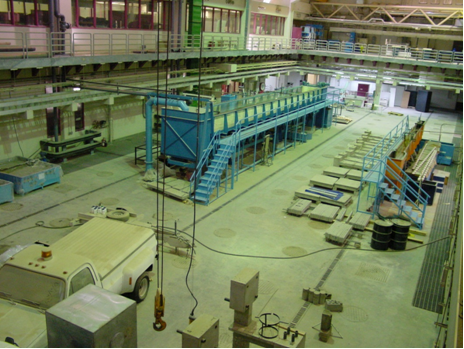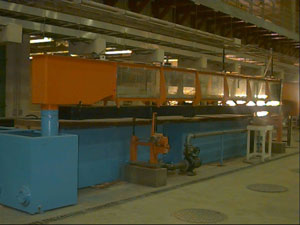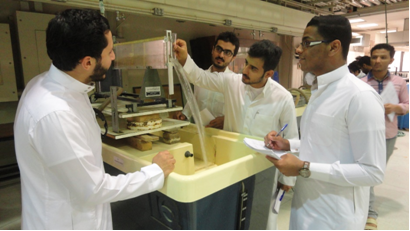Hydraulics and Fluid Mechanics Lab
Hydraulics and Fluid Mechanics Laboratories
Water networks and drainage channels are considered as one of the most important infrastructure component for any city/civilization. The hydraulics subject is focusing on that side of infrastructure requirements; the hydraulics laboratory in the civil engineering department is fully equipped with all the facilities, which always facilitated to be in the services of society for the use of water for domestic, commercial and agricultural purposes through supply networks and drainage channels.
In hydraulics laboratory there is a range of experimental set-ups through which students are given a very good demonstration to understand the various methods of measurement of flow rates, capacity & velocity of water in tanks, closed pipes and open channels. In addition, in this laboratory, students get an experience to understand the fluid properties like surface tension, temperature, viscosity and they get a practical experience of measurement of these properties, which are very important for the selection of pumps, pipes and its specifications like material, size & slope. It is quite useful for design of drainage channels and open channel.
In Hydraulics laboratory, we use to find and verify the difference between the theoretical calculations and actual quantities of flow and its parameters in a pipe network or open channels. By using the experimental set-ups like losses through closed pipes, flow through orifice meter, flow through venturimeter or flow in open channels, we get the coefficient of various parameters like discharge, velocity etc. These coefficients represent a realistic relationship between theoretical calculations and actual observations, which ultimately enables us to find an accurate and appropriate estimate of parameters like flow rate, capacity, velocity, pressure, slope etc. to calculate the required dimensions and hydraulic specifications for the desired application of civilian and non-civilian purposes/projects.
Hydraulics laboratory, through its water group staff, contributes its services in the society by conducting the various listed experiments during the studies and research programs, these studies include individual studies or others supported by King Abdul Aziz City foe Science & Technology (KACST) and other government agencies. In addition, this modern laboratory has the facilities for the students in the department to get a good chance to experience and practice the recent technologies of hydraulics and fluid mechanics through experimental set-ups, which will lead them towards the opportunities to work in their society in different fields for the betterment of society in a scientific manner.
Apparatus/Facilities in the Hydraulics & Fluid Mechanics Laboratories
|
S.No. |
Name of Laboratory |
Name of Apparatus(Instrument) or Facility |
Type of Test or analysis performed by the apparatus(Instrument) |
Location of Apparatus |
Person In charge |
Contact Number |
|
1 |
Hydraulics & Fluid Mechanics |
Orificemeter |
To determine the coefficient of discharge of Orifice and measure flow rate |
1 B 8 |
Eng. Shamshad Alam |
46-76916 0557334714 |
|
2 |
Horizontal converging-diverging duct of varying width with piezometers |
To verify Bernoulli's theorem and measure pressure variation
|
||||
|
3 |
Venturimeter |
To find the coefficient of discharge of Venturimeter and measure flow rates |
||||
|
4 |
Jet Impact Apparatus |
To find the force exerted by a jet of water on a stationary vane & to verify the impulse momentum equation |
||||
|
5 |
Rectangular Notch and V-Notch |
To determine the coefficient of discharge of Rectangular & V-Notch and to determine the relationship between head and flow rate over weir having rectangular and V-sections. |
||||
|
6 |
Floating Pontoon with rigid sail |
To check the stability of a floating body (buoyancy force and its effect on stability by finding metacentre of floating vessel.) |
||||
|
7 |
Fluid friction Apparatus |
To find the losses in energy due to friction losses in pipes and pipe fittings |
||||
|
8 |
Open Channel Assembly with Flow/current meter; Rectangular Glass Channel |
|
||||
|
9 |
Cavitation Demonstration Apparatus |
To investigate the effect of cavitation |
||||
|
10 |
Hydrostatic Bench & Fluid Properties |
A self contained and mobile unit for demonstration of the properties of fluid & hydrostatics to determine densities, specific gravities, viscosity etc. |
||||
|
11 |
Laminar and turbulent Flow Bench/Table Unit |
To demonstrate laminar and turbulent flow in pipes and the transition between them, students can investigate the relationship between Reynolds number and friction factor, and velocity distribution. |
GB 007 |
Eng. Shamshad Alam |
46-76916 0557334714 |
|
|
12 |
Hydraulics Laboratory
|
Model Reservoir and Surge Tower Apparatus |
An application of the mass-continuity equation to an unsteady flow; it shows flood routing performance of a reservoir, demonstration of a surge tower. |
|||
|
13 |
Glass sided tilting flume |
For study of fluid mechanics, investigation of hydraulic structure, can be set-up for sedimentary transport studies and fluid/structures interaction investigations e.g.; measurement of force acting on a hydraulic gate. It can be used for investigation of gradually varied flow properties in non-uniform channel flow. It provides the facility for modeling of flow through a Parshall Flume |
||||
|
14 |
Stream Line Hot Wire Anemometer |
For single- or multi-point measurements of velocity and turbulence, measurement of fluctuating temperatures, gas and liquid flows, transient and cyclic flow phenomena, 1-, 2- and 3-velocity components, boundary layer transition and wall shear stress. |
||||
|
15 |
Basic Hydrology System |
To demonstrate on a small scale the relationship between rainfall and run-off from catchment areas of varying permeability and the abstraction of ground water by wells, both with and without surface recharge from rainfall. |
|
|||
|
16 |
Recording Rain Gauge (Hellman Type-1509-20WFaS) Rain Gauge (Hellman Type-1500 Non Recording) |
|
||||
|
17 |
Mechanical Wind Recorder (Woelf type No. 1482) |
It is used to register wind conditions over a relatively long period of time. Since the instrument does not require any sort of auxiliary energy supply to record the measured values, it can be set up anywhere. The instrument can be used in wind velocities ranging from 0 to 60 m/s. |
||||
|
18 |
Transducer Meter (Type C56R) |
a device that converts a signal in one form of energy to another form of energy and so it is helpful in investigating various parameters of flow. |
||||
|
19 |
|
Flowmeter (CaQ flow, CF-300 Series, PVC) |
Used to measure the amount of liquid, gas or vapor that passes through them |
|
|
|
Photos Gallery



